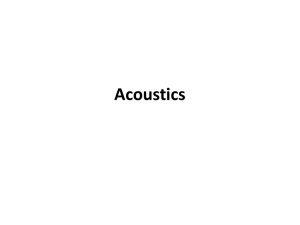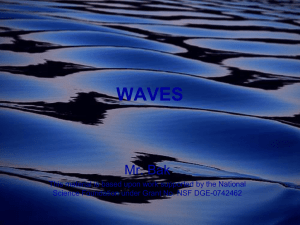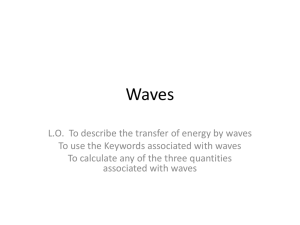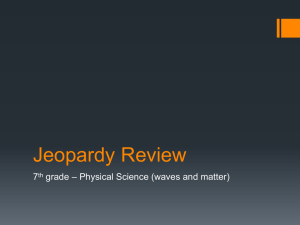lecture11
advertisement
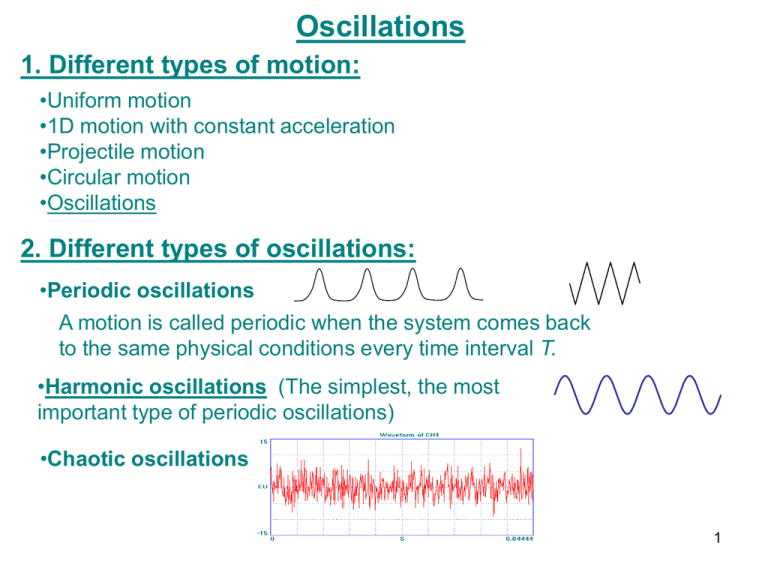
Oscillations 1. Different types of motion: •Uniform motion •1D motion with constant acceleration •Projectile motion •Circular motion •Oscillations 2. Different types of oscillations: •Periodic oscillations A motion is called periodic when the system comes back to the same physical conditions every time interval T. •Harmonic oscillations (The simplest, the most important type of periodic oscillations) •Chaotic oscillations 1 3. Harmonic oscillations Relation between circular motion and simple harmonic oscillations y t r=A 2 T 2 2f T x A cos x x A cost v A sin t a 2 A cost T – period f – frequency ω – angular frequency A – amplitude a 2 x linear equation Period of SHO is independent from amplitude! Units: f 1s 1 1/ s 1Hz 2 x T x xmax v0 a amax x xmax v0 a amax x0 v vmax a0 A=xmax t x0 v vmax a0 v t a t 3 4. Hook’s law and simple harmonic motion Newton’s second law: F kx F ma Simple harmonic motion: a x Hook’s law: ma kx k a x m 2 k m 2 1 2 m T 2 f k Question: Two identical masses hang from two identical springs. In case 1, the mass is pulled down 2 cm and released. In case 2, the mass is pulled down 4 cm and released. How do the periods of their motions compare? A. T1 < T2 B. T1 = T2 C. T1 > T2 Period is independent of amplitude! This is in fact general to all SHM (not only for springs)! 4 Question: Mass m attached to a spring with a spring constant k. If the mass m increases by a factor of 4, the frequency of oscillation of the mass 1. 2. 3. 4. is doubled is multiplied by a factor of 4 is halved is multiplied by a factor of 1/4 T 1 2 m 2 f k Question: A 2.0 kg mass attached to a spring with a spring constant of 200 N/m. The angular frequency of oscillation of the mass is __ rad/s. A. 2 B. 10 C. 60 D. 100 k m 2 k 200N / m 100rad / s 10rad / s m 2kg 5 5. The simple pendulum a g sin x L ma F mgsin L x L mg If g a x 2 x L 1 than sin x(t ) A cost 0 g 1 L ; f ; T 2 L 2 f g x t Period and frequency are independent from amplitude! Example: L 0.5m g 9.8m / s 2 4.4s 1 L 0.5m f 0.70 Hz 2 1 L T 2 1.4s f g 6 Example: A person swings on a swing. When the person sits still, the swing moves back and forth at its natural frequency. If, instead, the person stands on the swing, the new natural frequency of the swing is: A. Greater g L B. The same C. Smaller If the person stands, L becomes smaller Example: Grandpa decides to move to the Moon, and he naturally takes his old pendulum clock with him. But gravity on the Moon is approximately g/6... As a result, his clock is: A. Too fast B. Too slow C. Too fast until noon, too slow after noon 2 L T 2 g The period of the pendulum is longer on the Moon. So each “second according to this clock” is then longer than a real second. To tune the clock you can move the clock’s disk up. 7 6. Damped Harmonic Motion x(t) t 7. Resonance 8 Waves 1. There are many examples of waves: • • • • Seismic waves Ripples on a pond Sound Electromagnetic wave including light 2. Types of Waves • Wave pulses (waves that have short duration – just a quick pulse) • Periodic waves • Special type of periodic waves – sinusoidal waves Longitudinal wave: the oscillations are along the direction the wave travels. Transverse wave: the oscillations are transverse (perpendicular) to the direction the wave travels. 9 3. Sinusoidal waves y( x, t ) A sin(t kx) Wave at fixed x: y Wave at fixed t: y T A t Amplitude: A Period: T Wave length: Frequency: f 1 / T Angular frequency: Wave number: 2 / T 2f k 2 / λ x Sinusoidal waves are periodic a) A periodic wave is periodic in time at fixed position as the wave passes that position. The period of the wave is T. Each particle in the medium oscillates with the same period and in the same way as the wave passes the particle. b) A periodic wave is also periodic in space at fixed time. The period of the wave in space is called the wavelength . 10 4. Wavelength, period and speed of waves v / T f / k λ - wave length T - period • The “speed” of a wave is the rate of movement of the disturbance. • It is not the speed of the individual particles! • The speed is determined by the properties of the medium. Question 1: If you double the wavelength of a periodic wave and the wave speed does not change, what happens to the wave frequency f ? 1) f is unchanged 2) f is halved 3) f is doubled Question 2: A sinusoidal wave has a wavelength of 4.00 m and a period of 2.00s. What is the speed of the wave? v / T 4.00m 2.00s 2.00m s Question 3: A sinusoidal wave has a wavelength of 4.00 m and an angular frequency of 3.14 rad/s. What is the speed of the wave? v f 2 4.00m 3.14s 1 2 2.00m s 11 5. Interference – combination of waves (an interaction of two or more waves arriving at the same place) Important: principle of superposition (r , t ) 1 (r , t ) 2 (r , t ) Valley Peak (b) (a) Valley Waves source (b) (a) No shift or shift by r2 r1 m Shift by r2 r1 m 12 m 0,1,2,... a) Constructive interference: the interfering waves add up so that they reinforce each other (the total wave is larger) b) Destructive interference: the interfering waves add up so that they cancel each other (the total wave is smaller or even zero) 12 Example: Two speakers S1 and S2 are driven by the same signal generator and are different distances from a microphone P as shown. The minimum frequency for constructive interference to occur at point P is __ Hz. (The speed of sound is v = 340 m/s.) A. 100 r2 r1 n n 0,1,2,... f v / f min B. 200 C. 400 D. 800 v 340m / s 200Hz r 2 r1 3.40m 1.70m 13 6. Diffraction What it is? The bending of waves behind obstacles or apertures into the ”shadow region”, that can be considered as interference of many waves. Haw to observe? Diffraction is most pronounced when the wavelength of the wave is similar to the size of the obstacle or aperture. For example, the diffraction of sound waves is commonly observed because the wavelength of sound is similar to the size of doors. The waves spread out from the opening! 14 Sound Acoustic waves in the range of frequencies: 20Hz - 20,000Hz 1. Sound waves: • can travel in any solid, liquid or gas • in liquids and gases sound waves are longitudinal ONLY! • longitudinal and transversal sound waves could propagate in in solids Sound in air is a longitudinal wave that contains regions of low and high pressure Pressure sensor Vibrating tuning fork These pressure variations are usually small – a “loud” sound changes the pressure by 2.0x10-5 atm 15 Speed of Sound in Some Common Substances Substance Speed (m/s) 1. Air (20 oC) 344 2. Helium (20 oC) 999 3. Water (0 oC) 1,402 4. Lead 1,200 5. Human tissue 1,540 6. Aluminum 6,420 7. Iron and steel 5,941 16 2. Perception of Sound We use four subjective characteristics to describe how we perceive sound: pitch, loudness, tone quality and duration 1) Pitch - how “high” or “low” we perceive sound (it is directly related to how we perceive frequency) Combinations of notes that are “pleasing” to the ear have frequencies that are related by a simple whole-number ratio (Pythagoras) 2) Loudness - how we perceive the amplitude of the sound wave Loudness manly depends on amplitude and frequency 3) Tone quality - how we distinguish sounds of the same pitch and loudness (how we perceive the qualities of the waveform) 4) Duration 17 3. Doppler Effect What do you hear when a sound-emitting object (train, car) passes you? The sound changes in pitch (frequency) as the object goes. Why does this happen? v f •As the object travels towards you, the distance between wavefronts is compressed; this makes it seem like is smaller and frequency is higher. •As the object travels away from you, the distance between wavefronts is extended; this makes it seem like is larger and frequency is lower. Because the speed of a wave in a medium is constant, change in will affect change in f. Velocity of listener (L): vL Velocity of source (S): vS Velocity of sound: v v vL f L f S v vS vL or vS is “+” if in the same direction as from listener to source and is “-” otherwise 18 4. Slightly mismatched frequencies cause audible “beats” f beats f 2 f1 Question: The beat frequency between tones with frequencies f1 and f2 is 2.0 Hz. In order to increase the beat frequency, one must __. A) Increase f1; D) Decrease f2; B) Increase f2; C) Decrease f1; E) There is not enough information to choose 19



